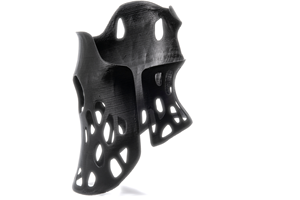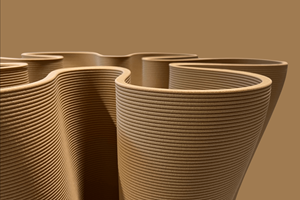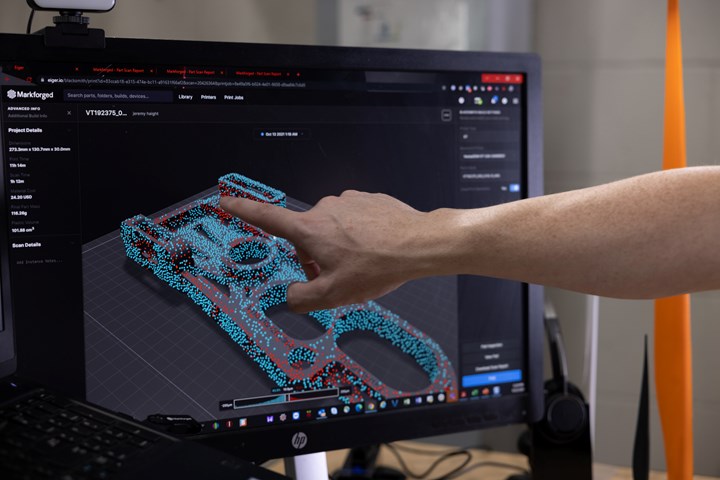
Wind turbines are massive and expensive machines that must function reliably with minimal downtime in order to be as effective as possible. That means there’s no room for error when it comes to manufacturing and installation. As a result, wind turbine manufacturer Vestas (Aarhus, Denmark) has depended on specialized inspection gauges at its manufacturing facilities and inspection sites, often requiring parts to be sent between various facilities. However, this process can be time consuming, and adds onto the time and production costs needed to produce specialized wind blade components.
To eliminate these bottlenecks, in 2021 Vestas launched a program at its blade production facilities to produce many of these components in a more streamlined, digitized way via additive manufacturing (AM). Vestas’ direct digital manufacturing (DDM) program uses Markforged’s (Cambridge, Mass., U.S.) cloud-based, AI-powered Digital Forge AM platform, 3D printers and materials to produce thousands of specialized parts quickly and on the site where they are needed.
One of these parts is a carbon fiber-filled composite top center (TC) marking tool (shown in images and in video below) that is used by the wind blade assembly team in the field. Using the tool as a measurement, an indicator mark is placed on the root of the blade to ensure the blade is aligned at the correct pitch during installation. This tool, which originally took weeks to manufacture, ship and then validate for use, is now being made in only a few days.
Previously, Vestas machined these tools from metal, and validation involved shipment of the tools to a facility to check alignment against the blades themselves — this process could take about three weeks including manufacture and validation.
Now, with the DDM system in place, the tools can be designed anywhere and then printed directly at the blade facility using Markforged’s X7 fused deposition modeling (FDM) printer and Onyx carbon fiber-filled nylon blend material. The Blacksmith tool within Markforged’s software platform performs digital inspection and calibration of the tool and generates a calibration report, eliminating the need for a physical inspection and calibration step. The switch to composites also results in 85% total weight savings for the part.
Today, the DDM program is said to include more than 2,000 total Vestas parts, including composite parts like the TC marking tool. The design files for all of these parts are stored in a Markforged Eiger cloud-based digital repository. This enables employees at any Vestas location — even those with little or no AM expertise — to quickly search for and print fiber-reinforced composite parts on their local X7 printers.
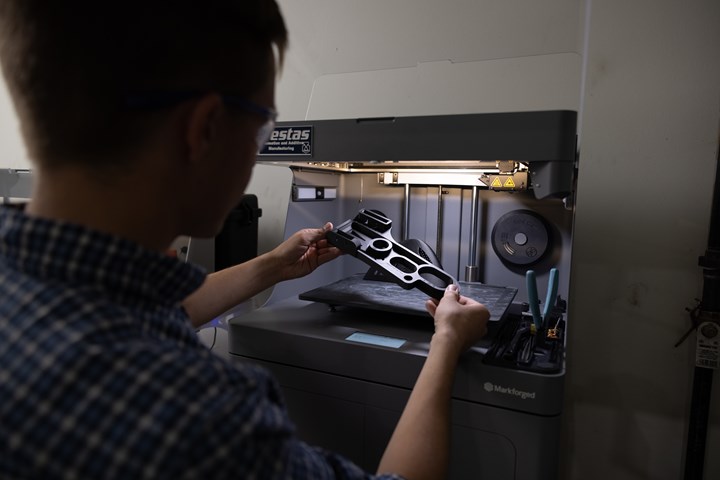
According to Jeremy Haight, principal engineer – additive manufacturing and advanced concepts at Vestas, “Our approach is end to end. We provide the physical article in near real time to a variety of places. It’s the closest thing to teleportation I think you can get.”
Thanks to the repository, the Vestas team can manufacture consistent, up-to-spec parts at a moment’s notice, anywhere in the world without the need for specialists at global facilities. This is said to have dramatically reduced shipping and freight costs, as well as manufacturing lead times. Most importantly, the Vestas team no longer has to worry about parts failing compliance tests because they are printed on-demand and in-house using exact digital specifications. Also, tool accuracy is verified using Markforged Blacksmith for in-process inspection, analysis and reporting.
In 2022, Vestas says it will begin rolling out DDM for inspection gauge tooling beyond its blades to facilitate on-demand gauge production at all 23 of its manufacturing locations. Vestas has also partnered with fastener and assembly materials supplier (Künzelsau, Germany) to build an additive ecosystem and manage an inventory of spare parts made with Markforged’s Digital Forge platform to support maintenance, repair and overhaul (MRO) for local field support and other suppliers.
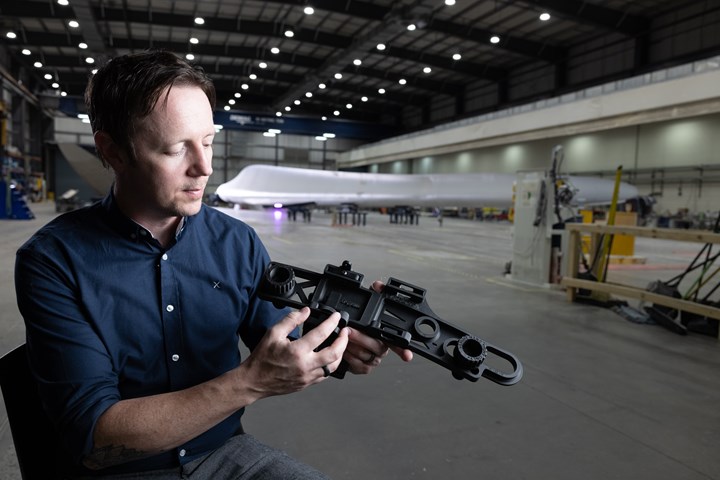
Once the initial rollout is complete, Vestas will turn its attention to implementing a more in-depth, end-to-end process at its sites. For example, the company is making it easier for individuals at any Vestas site with the right permissions to scan a part code or search for a part in its enterprise asset management (EAM) and enterprise resource planning (ERP) systems, and have it automatically sent to the right local 3D printer. This centralized control of users, printers and parts inspection, using Blacksmith and Eiger Fleet, will ensure high-quality, high-performing tools and end-use parts that do the jobs they’re designed to do.
Related Content
Multi-material, self-sensing, 3D-printed scoliosis braces
Startup Fited and Brightlands Materials Center have developed a lighter weight, thinner CFRP corrective brace, including pressure sensors made from continuous carbon fibers.
Read MoreAl Seer Marine, Abu Dhabi Maritime unveil world’s largest 3D-printed boat
Holding the new Guinness World Record at 11.98 meters, the 3D-printed composite water taxi used a CEAD Flexbot to print two hulls in less than 12 days.
Read MoreHitachi Rail chooses Roboze printers, materials including carbon fiber/PEEK for railway spare parts
The Roboze ARGO 500 will be used at Hitachi Rail factories in Naples, Italy and Maryland, U.S. to reduce cost and delivery times for prototypes and spare parts.
Read MoreSulapac introduces Sulapac Flow 1.7 to replace PLA, ABS and PP in FDM, FGF
Available as filament and granules for extrusion, new wood composite matches properties yet is compostable, eliminates microplastics and reduces carbon footprint.
Read MoreRead Next
Ceramic matrix composites: Faster, cheaper, higher temperature
New players proliferate, increasing CMC materials and manufacturing capacity, novel processes and automation to meet demand for higher part volumes and performance.
Read MoreNext-gen fan blades: Hybrid twin RTM, printed sensors, laser shock disassembly
MORPHO project demonstrates blade with 20% faster RTM cure cycle, uses AI-based monitoring for improved maintenance/life cycle management and proves laser shock disassembly for recycling.
Read MoreUltrasonic welding for in-space manufacturing of CFRTP
Agile Ultrasonics and NASA trial robotic-compatible carbon fiber-reinforced thermoplastic ultrasonic welding technology for space structures.
Read More
.jpg;width=70;height=70;mode=crop)






